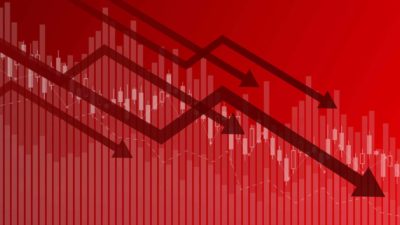Australian markets awoke to turbulence this morning as the S&P 500 Index, a benchmark for the US stock exchange, closed well into the red on Monday.
Over 99% of the S&P 500's members closed in negative territory, the highest number since June last year.
Geopolitical tensions between the US and China, a reset in investor confidence and fears of contagion — or flow-on effects — from the Evergrande debt crisis have woven into US equity markets.
This turbulence has got Australian investors talking about ASX SPI Futures today. Here we will discuss exactly what ASX SPI Futures are and why they are making the rounds in investor conversations.
What are ASX SPI Futures?
To answer this question, we first have to quickly cover what a Futures contract is.
Put plainly and simply, a futures contract is an agreement to buy or sell a particular asset (or commodity) at a predetermined price, at a set date in the future.
Doing it this way means you can "lock in" what price you will buy (or sell) your asset for and at what point in the "future" this will occur. Some even liken futures to a kind of insurance that covers major market events.
Companies and investors alike use futures contracts to protect their assets against price fluctuations or to speculate on these fluctuations for profit.
They've actually been around for hundreds of years and are an integral part of the global financial system.
Each futures contract has an expiry date and certain stipulations on the underlying asset, which could be commodities, share market indices, bonds and so on.
ASX SPI Futures contracts are the benchmark share market index futures contracts in Australia. They are based on Australian indices such as the S&P/ASX 200 Index (ASX: XJO).
For instance, the ASX SPI 200 Futures contract covers approximately 87% of the market capitalisation of listed securities in Australia.
It sounds fancy but you can buy and sell futures contracts on an exchange, just like you would with shares for instance. There are specific risks involved though, like leverage and margin.
How do they work?
Let's set up a hypothetical scenario to understand how it works – it's quite simple.
Let's say we own shares in an exchange traded fund (ETF) that tracks the S&P/ASX 200 Index (ASX: XJO).
A good example is the BetaShares Australia 200 ETF (ASX: A200) which currently trades at $124 and change.
That means the ETF, which trades just like a share, fluctuates with movements of the broad index.
So if the S&P/ASX 200 Index takes a hit so too will the Australia 200 ETF, which isn't ideal. Hence, we need something to protect, or "hedge", against this impact.
Enter futures contracts. We can "lock in" what price we are able to buy and/or sell for beforehand to prepare for this event.
Ideally, we want something in place that gives us cover if the Australia 200 ETF takes a nosedive.
So we would buy futures contracts that guarantee the price we can sell our ETF into the future – say at $120 for instance. It's a small cost for a big gain in cover — and here's why.
If the broad index does take a hit and sends the Australia 200 ETF from $124 to $90, we are covered as our futures contract allows us to sell our shares at $120.
So whilst everyone else is feeling the pain of seeing their investment dwindle, the ASX SPI futures contracts protected ours. That's the basic premise but there are obviously many more intricacies involved in derivatives markets, where futures trade.
So why again is everyone talking about ASX SPI Futures?
Traditionally, in times of financial market distress, or even expectations of distress, activity in the futures markets increases substantially.
So from explanations that futures are a "hedging" or protective-style instrument, it starts to make sense why ASX SPI Futures are a hot topic of conversation today.
Investors are looking to protect their ASX listed investments from any flow-on effects generated by global events.
To do so, they would have to head to the futures markets and purchase ASX futures that give them some assurance and cover over their equity investments.
As explained earlier, investors seeking to hedge against their shares depreciating in value would purchase ASX SPI Futures contracts that lock in a price they can sell for at some time in the future.
With this kind of uncertainty in global equity markets, it seems ASX SPI Futures are to stay in fashion.








